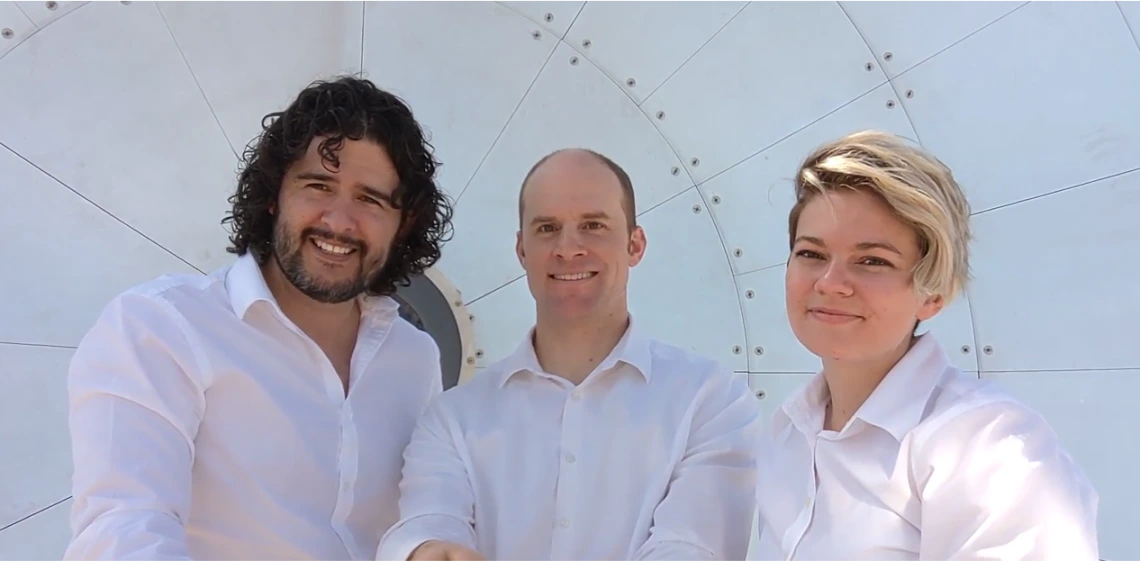UArizona Innovation Ecosystem Provides “a Wealth of Resources” for Engineering Startup

From left to right: Christian Davila, co-founder; Justin Hyatt, co-founder; Roslyn Norman, principal investigator
Courtesy of: Paramium Technologies
University of Arizona startup Paramium Technologies, founded to commercialize a precision metal plate forming technology invented by researchers in the Steward Observatory, has demonstrated how a small company can achieve big things with the support of a strong innovation ecosystem.
“We were looking for an opportunity to apply some ideas developed in the laboratory towards an industrial application that could be commercially exploited,” said researcher and co-inventor Christian Davila-Peralta. “We presented the case to TLA and with their help we were able to start our innovation journey.”
Started by Davila-Peralta and co-inventor Justin Hyatt, Paramium’s recent successes are the result of a clear, defined pathway through an interconnected series of steps and support systems provided by university offices like Tech Launch Arizona, the UArizona office that commercializes inventions stemming from university research and innovation, and the University of Arizona Center for Innovation, or UACI, the business incubator embedded at Tech Parks Arizona.
Hyatt and Davila-Peralta developed a method that allows for rapid, inexpensive production of highly customized curved sheet metal plates that are perfect for the precise work antenna manufacturers need. The new precision molding method they invented allows designers to request small changes without relying on expensive custom molds.
Experts in antennas and satellite communications, Hyatt and Davila-Peralta saw a technical problem looming that was not being addressed in the marketplace: with over 2,000 satellites orbiting the earth – and that number projected to grow eight-fold in the next 10 years – the world is going to increasingly need efficient ground station antennas that can accommodate high data rates.
Using today’s methods, manufacturing such antennas takes a great amount of precision, time, materials, and space for molding and machinery. If done strategically and with the right decisions along the way, the new technology could be a game-changer and the business a great success.
“We would have never made it without the amazing support we received from the TLA office,” said Davila-Peralta. “Their Asset Development program, their guidance, funding and support were invaluable to convert our research results into intellectual property and our ideas into a startup.”
Step 1: Explore the Opportunities
Tech Launch Arizona, or TLA, is part of the UArizona Research, Innovation and Impact unit. This team – made up of experts with experience in industry, intellectual property and entrepreneurship – provides services to help university inventors bring innovations they develop to the marketplace for maximum impact.
The inventors were introduced to TLA as graduate students working with their Ph.D. advisor, Roger Angel, who had also worked with TLA to commercialize inventions. They approached Senior Licensing Manager at the time Amy Phillips, who suggested that the technology had promise but was still early-stage and needed funding to move it forward so it could shine in the marketplace. They also needed to learn how to think less like scientists and more like entrepreneurs.
Step 2: Develop the Innovation, Team, and Business Model
Developing their methods towards being ready for the marketplace required funding – money that was not available through research grants. To bridge that gap, Phillips suggested that they engage in the TLA Asset Development program, which provides funding to help UArizona inventors advance early-stage inventions toward market readiness.
TLA also connected Hyatt and Davila-Peralta with Mentor-In-Residence Steven Wood, who has an extensive background in engineering startups. Along with providing personalized guidance, Wood suggested that the team take part in the NSF I-Corps program. Facilitated by TLA, I-Corps teaches academic inventors about customer discovery, exploring what potential customers exist, and how best to position their solutions for those customers.
To enhance their leadership team, Paramium hired Roslyn Norman, a recent UArizona graduate in Mechanical Engineering, as engineering manager. She brings experience gleaned from working at Paragon Space Development Corp and with NASA’s Artemis Mission.
Step 3: License the Technology and Plan for Growth
As a last step for this first phase of their enterprise, they worked with TLA to license the inventions from the UArizona to their new startup, Paramium Technologies.
Most recently, with help from TLA, Paramium applied for and received a $256,000 Small Business Innovation Research (SBIR) grant from the National Science Foundation. For their next phase of growth, the startup has been accepted into UACI where they will continue to develop their product and begin taking customer orders.
“We’re grateful for the example and inspiration of our advisor, Roger Angel, as well as our TLA commercialization mentor, Steve Wood,” Hyatt said. “TLA paved the way for us, mapping out each step to take. We would not be where we are now without their support.”
“Justin and Christian took full advantage of the wealth of resources provided through TLA to move their innovation from the lab into the marketplace,” said Bruce Burgess, director of venture development at TLA. “It’s rewarding to see their team come together, combining innovation and passion to develop real-world solutions to customer needs.”
The market for the technology is growing quickly. Paramium stands poised to meet the needs of communications antenna manufacturers worldwide with a high-quality, cost-effective solution designed, developed and produced right here in Tucson.

